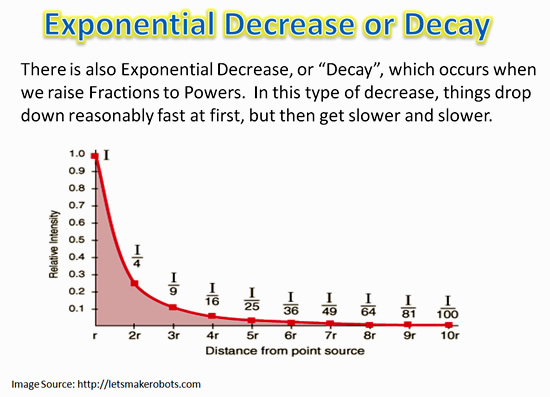Give A Real World Example Of An Exponential Growth Function
An exponential growth function is a mathematical function that describes a rapid increase in a value over time. This type of function is characterized by a variable in the exponent of the equation, resulting in a curved graph when graphed on the coordinate plane. A real world example of an exponential growth function can be seen in population growth. As human populations increase over time, the growth rate increases exponentially, resulting in an exponential growth pattern.
What is an Exponential Growth Function?
An exponential growth function is an equation used to describe the growth of a population or entity over time. This type of function is used to model a wide variety of phenomena, such as population growth, economic growth, and the spread of information and diseases. Exponential growth functions are characterized by a growth rate that increases as the population size increases, allowing for rapid growth within a short period of time.
Real world examples of exponential growth functions can be found in a variety of fields. For example, in economics, an exponential growth function can be used to model the growth of a company’s profits over time. In biology, an exponential growth function can be used to model the growth of a population of bacteria or other microorganisms. In the spread of infectious diseases, an exponential growth function can be used to model the rate at which a disease spreads in a given population.
In each of these scenarios, the exponential growth function can be used to accurately predict the growth rate of a population or entity over time. This allows us to make more informed decisions about how to manage or contain the growth of a population or entity. By understanding the underlying dynamics of exponential growth functions, we can gain a better understanding of how populations and entities grow over time.
How Does Exponential Growth Function Work?
Exponential growth functions are a mathematical tool to calculate the rate of growth of a population over time. These functions are used to model population growth, financial growth, and many other processes that involve exponential growth. By using an exponential growth function, you can identify the rate of growth of a population or quantity, and determine the amount of growth over a given period of time.
To illustrate how an exponential growth function works, consider a population of 100 individuals in a town. If the population grows by 5% each year, this means that the population will double in 14 years. This is because 5% of 100 people is 5 people, so each year the population increases by 5 people. Over 14 years, the population will increase by 70 people, which is the same as doubling the population.
In financial terms, exponential growth functions can be used to calculate the rate of return on investments. For example, if an investor invests $1,000 in a stock and earns a 10% return each year, this means that the investor will have earned $2,000 after 10 years. This is because 10% of $1,000 is $100, so each year the investor’s investments increase by $100. Over 10 years, the investor’s investments will have increased by $1,000, which is the same as doubling the original investment.
Exponential growth functions are powerful mathematical tools that can be used to model the rate of growth of a population or quantity. By understanding the concept of exponential growth, you can determine how long it will take for a population or quantity to double in size, or for an investment to double in value.
Common Uses of Exponential Growth Function
Exponential growth functions are incredibly useful mathematical tools that can be applied to a variety of scenarios. The concept of exponential growth is that the rate of growth increases as the base amount increases. In the real world, an exponential growth function can be used to measure population growth, economic growth, and the spread of disease.
For example, population growth can be modeled using an exponential growth function. The population of a given country can be modeled using a function that takes into account the fertility rate, mortality rate, and migration rate. By using an exponential growth function, we can accurately predict population growth over a given period of time.
Similarly, an exponential growth function can be used to model the spread of disease. As the number of people infected with a disease increases, the rate at which the disease spreads increases, until it reaches a maximum rate of spread. This is an example of an exponential growth function.
Finally, an exponential growth function can be used to model economic growth. By taking into account the rate of population growth, the rate of technological advancement, and the rate of investment, we can accurately predict the growth of the economy over a given period of time.
In conclusion, exponential growth functions are incredibly useful mathematical tools that can be used to model population growth, the spread of disease, and economic growth. By taking into account the relevant factors, we can accurately predict the rate of growth over a given period of time.

Real World Examples of Exponential Growth Function
Exponential growth functions are incredibly useful in mathematics, and can be applied to a variety of situations in the real world. To understand the concept further, it’s helpful to look at some real-world examples of exponential growth functions.
For instance, the population of a given species can be modeled using an exponential growth function. When the population of an animal is limited by its environment, it can grow exponentially until the resources in its environment are depleted. In nature, this often results in animals being overpopulated and diminishing their own food source.
Another example of an exponential growth function is the growth of a savings account over time. When money is deposited into a savings account, the sum of the account increases exponentially over time due to the interest accrued. This is one of the primary reasons why many people choose to invest their money for the long-term.
Exponential growth functions can also be used to model the spread of disease. When a virus is introduced to a given population, it can spread exponentially. This is because each person who is infected can then infect multiple other people, which can then infect multiple other people, and so on.
To sum up, exponential growth functions have a variety of applications in the real world. They can be used to model the growth of a species, the growth of a savings account, and the spread of disease. Understanding the concept of exponential growth functions is key to being able to apply them in a variety of situations.
The Benefits of Using an Exponential Growth Function
Exponential growth is a powerful concept used to model population growth, stock prices, and other real-world phenomena. It is characterized by an initial period of slow growth followed by a period of rapid growth. To understand the benefits of using an exponential growth function, let’s look at a real-world example.
One of the most famous examples of exponential growth is Moore’s Law. Moore’s Law states that the number of transistors on a given area of integrated circuit doubles about every two years. This law has held true for over 50 years and is the basis for the modern semiconductor industry. Due to this exponential growth, we are able to create faster, smaller, and more powerful computers and other devices.
Another example of exponential growth is bacteria growth. Bacteria reproduce quickly and in large numbers. In a laboratory setting, bacteria can double in number every 20 minutes. This means that the population of bacteria can exponentially increase if left unchecked.
These examples demonstrate the power of exponential growth and how it can be used to model real-world phenomena. However, it is important to note that exponential growth is not always beneficial. In the case of bacteria, exponential growth can lead to dangerous levels of contamination if it is not monitored and managed properly.
To conclude, exponential growth is a powerful concept that is used to model and understand population growth, stock prices, and other real-world phenomena. It is important to understand the benefits and drawbacks of exponential growth so that it can be used responsibly and safely.
Challenges Associated With Exponential Growth Function
Exponential growth is an exciting concept, but it comes with its own set of challenges. It is a type of growth that occurs when a quantity increases at a rate that is proportional to its current value. This means that the rate of growth increases over time. This type of growth can often be seen in areas such as population growth, economic growth, and technological development.
Exponential growth can be difficult to manage and can lead to a variety of issues. For example, exponential growth can quickly lead to resource scarcity. If the resources needed to accommodate the growth are not available, then the growth can become unsustainable. Additionally, exponential growth can lead to environmental problems. If the rate of growth exceeds the rate at which the environment can regenerate resources, then the environment can become damaged or destroyed.
It is important to understand the challenges associated with exponential growth. These challenges include resource scarcity, environmental damage, and inadequate infrastructure. To manage these issues, it is important to have a plan for managing resources, investing in infrastructure, and ensuring that the environment remains healthy. By understanding the challenges associated with exponential growth, it is possible to create sustainable growth.
FAQs About the Give A Real World Example Of An Exponential Growth Function
Q1: What is an exponential growth function?
A1: An exponential growth function is a type of mathematical function that displays exponential growth over time, meaning that the rate of growth increases at an exponential rate.
Q2: What is an example of an exponential growth function?
A2: An example of an exponential growth function is the compound interest equation. This equation calculates the amount of interest earned on an investment over time, with the interest rate compounding each period.
Q3: What is a real world example of an exponential growth function?
A3: A real world example of an exponential growth function is population growth. Population growth follows an exponential growth function, where the rate of population growth increases exponentially over time.
Conclusion
Exponential growth functions are essential in understanding how certain populations grow and change over time. A real world example of an exponential growth function is the population of a species of fish in a lake. As the population of the species increases, the rate of growth increases exponentially. This is due to the fact that as the population grows, the amount of food available to the fish increases, leading to more offspring and a larger population. As the population continues to grow, the rate of growth continues to increase in an exponential fashion.


